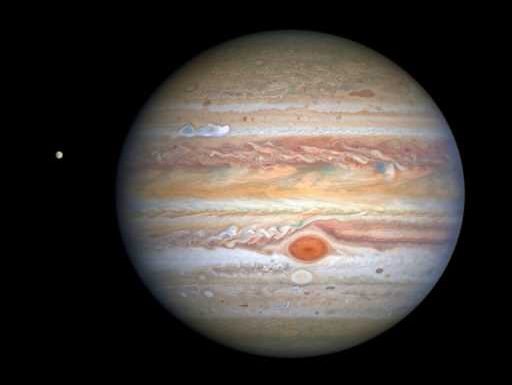
If you’ve noticed an unusually bright object in the sky recently, we’ve got an explanation for that.
It’s the planet Jupiter, which is approaching its closest distance to Earth since 1951 and won’t be this close again until the year 2129 — 107 years from now.
Here’s what’s happening: Jupiter is approaching a position in the solar system whereit is in “opposition” to Earth — which means directly opposite the sun in relation to Earth — as Earth passes between it and the sun. That’s reducing the distance between Earth and Jupiter every day. At conjunction, it will be 366 million miles away. It can be as far as 600 million miles.
Jupiter reaches its opposition point every 13 months, but there’s another reason the planet appears so bright. It also is approaching its “perihelion,” which is the closest it gets to the sun in its orbit. Its perihelion will occur in January.
“Jupiter isn’t always exactly closest to earth on the day of its opposition,” explains the astronomy site EarthSky. “But in 2022, Jupiter’s opposition to the sun and closest approach to earth fall on the same day. That’s because opposition takes place so near in time to Jupiter’s perihelion. If it’s nearly closest to the sun, and we go between it and the sun … it’s a close opposition for us. The juxtaposition of Jupiter’s opposition in late 2022, and perihelion in early 2023, brings the planet closer to earth at this opposition than it has been for 70 years.”
Currently, Jupiter becomes prominent in the eastern sky after sunset and crosses the sky overnight, remaining visible in the western sky at sunrise. It will rise above the eastern horizon later and later in the evening until it reaches opposition on Sept. 26, when it will rise right at sunset.
Jupiter is the largest planet in the solar system and typically is the third-brightest celestial object in the nighttime sky after the moon and Venus, according to Ron Hranac of the Denver Astronomical Society. The International Space Station can appear brighter than Venus and Jupiter, though, depending on where it is in its orbit.
According to Jeffrey Hunt, a retired Illinois planetarium director whose website (whenthecurveslineup.com) tracks easily observed celestial events for amateur sky gazers, Jupiter has grown 2.5 times brighter than it was last spring when it was in a position of “super conjunction,” meaning it was on the opposite side of the sun in relation to Earth.
“During April, Jupiter was 5.9 times Earth’s distance to the sun from us,” said Hunt, using a unit of measurement known as Astronomical Units, which are equivalent to the average distance between the Earth and the sun. “At opposition, the separation (will be) reduced to 3.9 times the Earth-sun distance.”
Jupiter has more than 70 moons, four of which were discovered by Galileo with a telescope in 1610, and some may become visible through binoculars as it grows closer to Earth this month.
Subscribe to our weekly newsletter, The Adventurist, to get outdoors news sent straight to your inbox.
Source: Read Full Article









